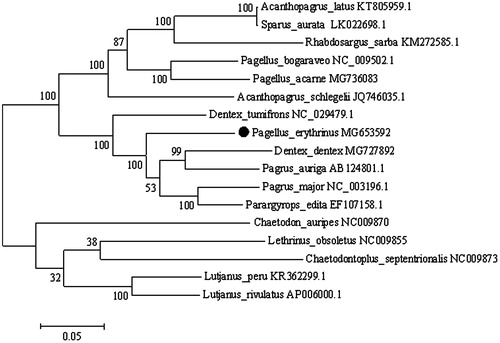Abstract
The common pandora (Pagellus erythrinus, Linnaeus 1758), one of the most popular sea bream species in the Mediterranean Sea, has high potential for aquaculture development. In this investigation, we analyzed the complete mitochondrial genome of P. erythrinus. The sequence has 16,828 bp in length and consists of 13 protein-coding genes, 2 rRNA genes, 22 tRNA genes, and a two non-coding regions (D-loop and L-origin). The overall nucleotide composition is: 27.5% of A, 28.2% of C, 27.5% of T, and 16.8% of G.
The common pandora (Pagellus erythrinus) is a benthopelagic sparid that is distributed in the eastern Atlantic Ocean and Mediterranean Sea (Sanches Citation1991). It is also rarely recorded in Scandinavia and in the Black Sea (Bauchot and Hureau Citation1986). Pagellus erythrinus is one of the sparid fishes that are harvested commercially in the greatest amounts in the Mediterranean Sea, and its potential as a significant aquaculture species is recognized (Basurco et al. Citation2011). However, the genetic information about this species are yet to be adequately addressed. Here, we report the complete mitochondrial genome (mitogenome) of P. erythrinus (GenBank MG653592). A specimen caught in the Mediterranean Sea (N 40°22'54.0" E 14°35'44.0") was identified on anatomical and morphological features. DNA extracted from dorsal fin tissue is currently stored at Department of Veterinary Medicine and Animal Production, University ‘Federico II,’ Naples, Italy. The complete mitogenome of P. erythrinus was determined by using a combination of long and short PCR, followed by Sanger and Illumina HiSeq 2500 System (Illumina, San Diego, CA) sequencing methods. The complete sequence is 16,828 bp long, containing 13 protein-coding genes, 2 ribosomal RNA genes (12S rRNA and 16S rRNA), 22 transfer RNA genes (tRNA), and two non-coding regions (D-loop and L-origin). Mitochondrial structure and gene organization are in agreement with the typical vertebrate mitogenome (Pereira Citation2000). The majority of mitochondrial genes were encoded on the heavy strand, with the NADH dehydrogenase subunit 6 (ND6) and eight tRNA genes [Gln, Ala, Asn, Cys, Tyr, Ser(UCN), Glu, Pro] being encoded on the light strand. Base composition is 27.5% of A, 28.2% of C, 27.5% of T, and 16.8% of G, similar to other Sparidae mitochondrial genomes (Ceruso et al. Citation2018). All protein-coding genes started with an ATG start codon with the exception of COI and ND4, which started with GTG. Four types of stop codon were detected, i.e. TAA (ND1, ND2, ATP8, ATP6, COIII, ND4L, ND6), AGG (COI), T (COII, ND4, CYTB), and TAG (ND3, ND5). The 12S and 16S rRNA genes were located between the tRNAPhe (GAA) and tRNALeu (TAA) genes, and were separated by the tRNAVal gene as in other vertebrates (Mascolo et al. Citation2018). The 22 tRNA genes vary from 66 to 74 bp in length. The 1154 bp long control region is located between tRNAPro (TGG) and tRNAPhe (GAA). The non-coding region (L-strand origin of replication) is 31 bp long and is located between tRNAAsn (GTT) and tRNACys (GCA). The phylogenetic position of P. erythrinus was examined based on 11 entire sparid mitogenome sequences available in GenBank, using MEGA6 software (Tamura et al. Citation2013). The species Lutjanus peru, Lutjanus rivulatus, Lethrinus obsoletus, Chaetodontoplus septentrionalis, and Chaetodon auripes were used as out-group for tree rooting (). The resultant phylogeny shows that P. erythrinus is closely related to Dentex tumifrons and Pagrus spp., in agreement with the work of Chiba et al. (Citation2009). The complete mitochondrial genome of P. erythrinus will increase our understanding of phylogeny, evolution, and species assignment of sparids.
Acknowledgements
The authors thank the Molecular Biology and Sequencing unit of the Stazione Zoologica Anton Dohrn for technical assistance.
Disclosure statement
The authors report no conflicts of interest. The authors alone are responsible for the content and writing of the paper.
Additional information
Funding
References
- Basurco B, Lovatelli A, Garcia B. 2011. Current status of Sparidae aquaculture. In: Pavlidis M, Mylonas CC,. Sparidae, biology and aquaculture of gilthead sea bream and other species. Oxford: Blackwell Publishing Ltd; p. 1–50.
- Bauchot ML, Hureau JC. 1986. Fishes of the north-eastern Atlantic and the Mediterranean. In: Whitehead PJP, Bauchot M-L, Hureau J-C, Nielsen J, Tortonese E, editors.The quaterly review of biology. Paris: The University of Chicago Press; p. 883–907.
- Ceruso M, Mascolo C, Palma G, Anastasio A, Pepe T, Sordino P. 2018. The complete mitochondrial genome of the common dentex, Dentex dentex (Perciformes: Sparidae). Mitochondrial DNA Part B. 3:391–392.
- Chiba SN, Iwatsuki Y, Yoshino T, Hanzawa N. 2009. Comprehensive phylogeny of the family Sparidae (Perciformes: Teleostei) inferred from mitochondrial gene analyses. Genes Genet Syst. 84:153–170.
- Mascolo C, Ceruso M, Palma G, Anastasio A, Sordino P, Pepe T. 2018. The complete mitochondrial genome of the axillary seabream, Pagellus acarne (Perciformes: Sparidae). Mitochondrial DNA Part B. 3:434–435.
- Pereira SL. 2000. Mitochondrial genome organization and vertebrate phylogenetics. Genet Mol Biol. 23:4.
- Sanches JG. 1991. Catálogo dos principais peixes marinhos da República de Guiné-Bissau. Publ Avuls Inst Nac Invest Pescas. 16:429.
- Tamura K, Stecher G, Peterson D, Filipski A, Kumar S. 2013. MEGA6: Molecular Evolutionary Genetics Analysis version 6.0. Mol Biol Evol. 30:2725–2729.

